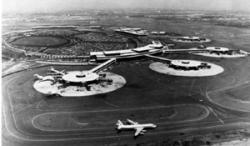
In May 1927, the same month of Charles A. Lindbergh's famous transatlantic flight from New York to Paris, a fact-finding commission appointed by the U.S. Secretary of Commerce concluded that Newark would be the ideal location for an airfield to serve the greater New York/New Jersey metropolitan area.
Civic leaders wasted no time; construction began on the Newark Airport in January 1928. Nine months and $1,750,000 later, 68 acres of soggy marshland had been filled and converted to an airport.
The new airport featured the nation's first hard-surface runway-1,600 feet long, covered with asphalt-and a 120-square-foot hangar. Newark was designated as the airmail terminus for the eastern U.S. in 1929 and scheduled passenger service also started then. By the fall of 1930, it was the world's busiest commercial airport. Today, expanded many times over, Newark Airport continues to serve millions of passengers and transfer tons of cargo each year.



- Major John Berry, An Air Terminal Extraordinary, 1930